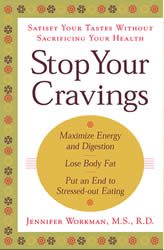|
Strength
in Balance®
"Balance
is the all-important factor in a fighter's attitude or stance.
Without balance
at all times, he can never be effective."
Bruce Lee, The Tao of Jeet Kune Do
Increase Lean Muscle, Burn Fat, and Relieve Stress through Exercise
Bringing together the most cutting-edge information on fitness,
strength training, flexibility, yoga, and stress management.
Let us help you put together a specific work-out program based on your
body type that will complement your eating plan and help you lose body
fat, increase lean muscle, maximize sports performance, and balance
energy!
Strength in Balance will refer you to the best strength/fitness
trainers and body-workers in the industry.
Ayurveda
meets Western Fitness:
Vata,
Pitta, Kapha-Your Constitutional Type can help you determine the best plan.
And then it will change for the season, your goals, etc....
Below are excerpts from The Strength in
Balance chapter of
Stop Your Cravings |
 |
Just as there is no perfect "one size fits all" diet,
there is no one exercise program that will be appropriate or effective for all
people. And, if something-be it diet or exercise-doesn't produce results,
no one is going to stick with it.
Getting started seems to be the hardest part of any
program. Many people think that if
they can't work out every day, there's no point even in starting. You can
"start small" and still get results and you should want to stick to your
program because it feels right!
Vatas are drawn to
movement. When Vata is imbalanced, (in just about everyone in America),
it's hard to sit still. Feeling stressed, anxious, nervous, worried, traveling
too much, flying, moving, or any kind of change can cause a Vata imbalance.
Doing more and more aerobic activity -spinning, stepping, and running can then
cause even more of an imbalance. Try to balance all the aerobic activities with
some strength training to increase lean muscle and Yoga, Tai Chi, or Pilates to
"ground" and calm you down. Since Vata body types are usually thin you
don't need to lose any more body fat, but you do need to build lean muscle,
relieve some stress, and support your nervous system. The goal is to balance and
nurture your tired wired adrenal glands and nervous system, not force you to sit
still and meditate. Most Americans
are overstressed, moving too fast, and over-training in aerobic activity.
Exercise has been shown to increase the levels of endorphins and
serotonin in the brain, making people feel better about themselves, while lack
of exercise is equally shown to increase susceptibility to depression.
If some exercise is good, more is not always better.
The old ideas of cutting calories and fat while over-training in aerobic
activity can eventually cause injuries and fatigue. Try a more "balanced approach" to feel strong, grounded,
clear, and energized.
Pittas are the fiery
type, most biologically adapted to develop muscle and usually enjoy competing in
their work-outs. An out of balance Pitta, Type A personality, may not have an
exercise plan because they are working 80 hours/week and always pushing too
hard. Working until you develop high blood pressure or drop from exhaustion is
not a balanced approach to life or fitness. Stress is counter-productive to your
weight loss goals, as cortisol and other stress hormones increase body fat!!
Extreme exercise in the middle of a hot summer, or the hottest part of
the day may also exhaust and imbalance a fiery body type. Adding some weight
lifting, Pilates, and a cooling calming yoga class may help a lot.
The goal is to harness all that amazing Type A energy the way a martial
arts master can do, so that you become more efficient and
productive with less stress and strain.
More is not always better!
Kaphas are usually
bigger thicker body types and the most exercise-resistant.
They of course, are the ones who would benefit most from getting
themselves moving to crank up their metabolism. Movement of any kind will help
and early morning is best since the Kapha time of day is from 6 am- 10 am.
The longer you sleep in, the more lethargic and congested you will feel
and then you won't feel like getting up or moving. Once you get in a groove,
even walking around the block in the morning for 20 minutes, you should begin to
feel lighter and less sluggish. Combining
some cardiovascular activity with strength training to increase lean muscle
along with gentle yoga will help start clearing clogged channels, get
things stimulated, and provide a well-rounded program you can live with and
enjoy. Just get moving in some
direction, even 20 minutes will help!
Strength/Resistance
Training:
Strength training, also called resistance training, is
defined as the use of resistance to build maximum muscle force. The resistance
can be supplied by weights; by isometric contractions, as in yoga; or by water,
as in swimming. Strength training is an essential component of any exercise
program, no matter what your body type.
Aerobics/Cardiovascular
Fitness:
Vatas:
Strength/resistance training two to three times per
week
Hatha,
Integral, or Iyengar Yoga or Tai Chi at least twice a week
Interval training-good for working off excess
energy while building lean muscle and increasing
bone density
Pilates 2 times per week to increase core strength
Pittas:
Strength/resistance training 2-4 times/week depending on
goals followed by 20 minutes interval training
Hatha, Integral, or Iyengar, Level 1
Ashtanga, 2 times/week
on a day when you do no other form of exercise
Pilates 2 times week (followed, if you like, by 20 minutes
of interval training
Recreational, aerobic exercise such as biking, hiking,
skiing, swimming, on weekends
Kaphas:
Weight or interval training 2 to 4 times a week to increase
lean muscle and improve metabolism
Hatha, Iyengar, Bikrams, Ashtanga, or another of the more
aggressive forms of yoga twice a week
Recreational aerobic activities such as running, hiking, or
rowing
|